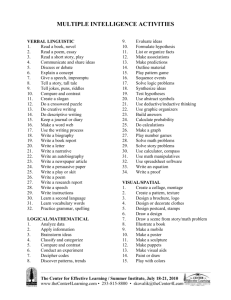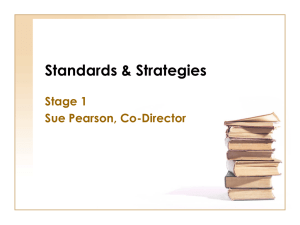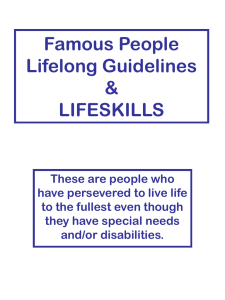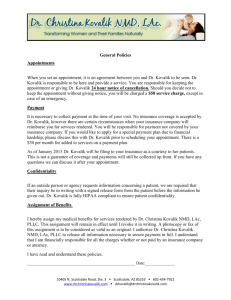Sope Creek 2010 MTW day one
advertisement
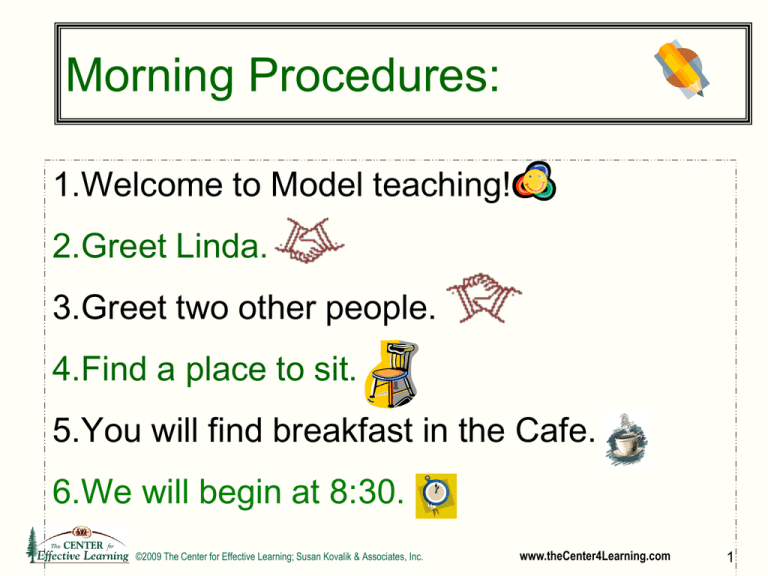
Morning Procedures: 1.Welcome to Model teaching! 2.Greet Linda. 3.Greet two other people. 4.Find a place to sit. 5.You will find breakfast in the Cafe. 6.We will begin at 8:30. ©2009 The Center for Effective Learning; Susan Kovalik & Associates, Inc. www.theCenter4Learning.com 1 Model Teaching Week June 2010 Stage 1- Co-Teaching HET: Jill Hay K-1 Mrs. Hinz & Ms. Francis 2-3 Small Group, Mrs. Vaniman & Mr. Houser 2-3 Mrs. Lance & Ms. Mauldin 4-5 Mrs. Braddy & Mrs. Auchenpaugh Stage 2-HET: Linda Jordan ©2009 The Center for Effective Learning; Susan Kovalik & Associates, Inc. www.theCenter4Learning.com 2 College Credit for this week Lewis and Clark University 3 Credits ©2009 The Center for Effective Learning; Susan Kovalik & Associates, Inc. www.theCenter4Learning.com 3 Today’s Time Lines • • • • • • • • 8:00-8:30 Breakfast 8:30-9:00 Linda 9:00- 9:20 Classroom Visit (Environment) 9:20-12:00 Linda 12:00-12:45 Lunch-on your own 12:24-1:00 ILP/Co-Planning 1:00-2:30 Linda 2:30-3:00 3rd Classroom Visit ©2009 The Center for Effective Learning; Susan Kovalik & Associates, Inc. www.theCenter4Learning.com 4 CLASSROOM: WELCOME: OBSERVATIONS (3 visits today) DAY ONE THE BRAIN What’s New? P.E.R.K. & CLOSURE LEARNING IS A PARTNERSHIP BETWEEN BODY AND BRAIN Stage 1: Review Stage 2 Preview © Susan Kovalik & Associates, 2006 ©2009 The Center for Effective Learning; Susan Kovalik & Associates, Inc. Instructional Strategies www.theCenter4Learning.com 5 Meet the Jordan Men ©2009 The Center for Effective Learning; Susan Kovalik & Associates, Inc. www.theCenter4Learning.com 6 Classroom Observation Procedures • • • • • • Enter silently Remain silent Take notes Leave silently Take a Post-It-Note Leave questions and appreciations for the teachers you observe. ©2009 The Center for Effective Learning; Susan Kovalik & Associates, Inc. www.theCenter4Learning.com 7 CREATE A NAMETAG • Write your name on the name tag lines Name • Draw a circle and divide it into 4 parts Name • Draw a square next to the circle Name ©2009 The Center for Effective Learning; Susan Kovalik & Associates, Inc. www.theCenter4Learning.com 8 CREATE A NAMETAG Name 1 2 3 4 Number your circle 1,2,3,4 Listen to Linda for further instructions. ©2009 The Center for Effective Learning; Susan Kovalik & Associates, Inc. www.theCenter4Learning.com 9 Model Teaching Week • Honoring the teachers of teachers – They are not perfect – They are models Scenario: First day of school Superintendent, principal, 20 parents drop by to watch you teach ©2009 The Center for Effective Learning; Susan Kovalik & Associates, Inc. www.theCenter4Learning.com 10 HET Stages • Stage One: Physical and Emotional Environment • Stage Two: Mini-themes, Creating Yearlong Theme Map, Being There • Stage Three: Yearlong Theme Map Created, Writing Key Points and Inquiries • Stage Four & Five: Refinement Evaluate your teaching….Where are you? ©2009 The Center for Effective Learning; Susan Kovalik & Associates, Inc. www.theCenter4Learning.com 11 The HET Model Creating Context Biology of Learning Instructional Strategies HET Conceptual Curriculum Growing Responsible Citizens ©2009 The Center for Effective Learning; Susan Kovalik & Associates, Inc. www.theCenter4Learning.com 1.112 Definition of a Model One definition of “model” is: “Worthy of replication” ITI, as a brain-compatible model of education, is being replicated with success throughout the United States and in other parts of the world. ©2009 The Center for Effective Learning; Susan Kovalik & Associates, Inc. www.theCenter4Learning.com 1.1 13 Highly Effective Teaching CYCLE Graphic by Dean Tannewitz, Susan Kovalik & Associates Comprehensive Research Meaningful Assessment Rigorous Curriculum Powerful Lesson Design ©2009 The Center for Effective Learning; Susan Kovalik & Associates, Inc. www.theCenter4Learning.com 1.714 HET HISTORY 1978~ Susan Kovalik- US gifted programs 1984- present~ Brain research– integrated curriculum connection ITI The Model, Exceeding Expectations, etc. 1992-1999~ Slovakia connection 1999~ Accepted in the Catalog of School Reform as a replicable model 2008- Changed to Highly Effective Teaching Partnership with International Center of Leadership ©2009 The Center for Effective Learning; Susan Kovalik & Associates, Inc. www.theCenter4Learning.com 1.215 in Education Goals for the week. . . EVERYONE will: • Experience a brain-compatible environment • Network with other teachers in a similar grade level/position • Begin to develop a Year Long Theme • Increase the number of teaching strategies in your bag of tricks Susan Kovalik & Associates, 2006 www.theCenter4Learning.com SENSE OF BELONGING ACTIVITY Find your Circle 2 Buddy Introduce yourself to each other Find three things you have in common Be ready to share these with the group ©2009 The Center for Effective Learning; Susan Kovalik & Associates, Inc. www.theCenter4Learning.com 17 Book Focus: Instructional Strategies Worksheets Don’t Grow Dendrites by Marcia Tate Skim the book Share with your elbow partner what you find fascinating, validating (I already do that) and interesting. 4 Strategies per day ©2009 The Center for Effective Learning; Susan Kovalik & Associates, Inc. www.theCenter4Learning.com 18 Strategy 1 Brainstorming and Discussion • Brainstorm a list of questions prior to reading or a unit of study (skim chapter) • Learning clubs (families) stop and discuss • Bloom’s Taxonomy • Have students create questions • Use sentence starters • Think, pair, share • Wait time • Debate ©2009 The Center for Effective Learning; Susan Kovalik & Associates, Inc. www.theCenter4Learning.com 19 Bloom’s Taxonomy Using Technology ©2009 The Center for Effective Learning; Susan Kovalik & Associates, Inc. www.theCenter4Learning.com 20 Strategy 2 Drawing and Artwork • • • • • • Personal Pictionary Design a book jacket Posters Draw math problems Draw or label part of what they are learning Design a mural based on what they learned yesterday • Symbols to help recall information ©2009 The Center for Effective Learning; Susan Kovalik & Associates, Inc. www.theCenter4Learning.com 21 Strategy 3 Field Trips (Being There) • 20 Senses • Levels the playing field • Real World application of knowledge/skills ©2009 The Center for Effective Learning; Susan Kovalik & Associates, Inc. www.theCenter4Learning.com 22 OUR “20” SENSES Sight Hearing Touch Taste Smell Balance-Movement Vestibular Temperature Pain Eidetic Imagery Magnetic Infrared Ultraviolet Ionic Vomeronasal Proximal Electrical Barometric Geogravimetric Proprioception Visible Light Vibrations in Air Tactile Contact Chemical Molecular Olfactory Molecular Kinesthetic Geotropic Repetitious Movement Molecular Motion Nociception Neuroelectrical Image Retention Ferromagnetic Orientation Long Electromagnetic Waves Short Electromagnetic Waves Airborne Ionic Charge Pheromonic Sensing Physical Closeness Surface Charge Atmospheric Pressure Sensing Mass Differences Sensation of Body in Space ©2009 The Center for Effective Learning; Susan Kovalik & Associates, Inc. R. Rivlin and K. Gravelle, Deciphering Your Senses-1st 19 on list www.theCenter4Learning.com © Exceeding Expectations by Susan Kovalik & Karen D. Olsen, p.23 1.10 Strategy 4 Games • • • • • • • • Use current games and remake them Make original games Charades Wheel of Fortune Loop Game Bingo Pictionary Engage the Brain Games ©2009 The Center for Effective Learning; Susan Kovalik & Associates, Inc. www.theCenter4Learning.com 24 playwithyourmind.com Playing brain games exercises your cognitive abilities and improves your brain fitness • • • • • • • • • • • Word Games Logic Games Typing Games Math Games Search Games Memory Games Focus Games Mouse Games Card Games Multi-Tasking Games Spatial Games • • • • • • • • • • • Memory Eye-Hand Coordination Visual-Spatial Problem Solving Attention & Focus Processing Number Word Tease Blankout Word Toggle Word Grid ©2009 The Center for Effective Learning; Susan Kovalik & Associates, Inc. • • • • • • • • Memory Game Schedule Memory Game Iconic Memory Game Color Codes Word Order Color Match Spatial Memory Object Memory www.theCenter4Learning.com 25 “A journey of a thousand miles begins with a single step.” ~ Confucius ~ ©2009 The Center for Effective Learning; Susan Kovalik & Associates, Inc. www.theCenter4Learning.com 1.2 26 Change ©2009 The Center for Effective Learning; Susan Kovalik & Associates, Inc. www.theCenter4Learning.com 27 Teacher Rant ©2009 The Center for Effective Learning; Susan Kovalik & Associates, Inc. www.theCenter4Learning.com 28 LEVELS OF USE LEVELS NON-USE ORIENTATION PREPARATION When learning a new strategy, process, or skill INDICES No action taken—user doesn’t know about it. User has just acquired or is acquiring information and is exploring it. Preparing to use it, finding out more, gathering the necessary materials, and getting organized. MECHANICAL USE Use requires focus day by day on steps involved. ROUTINE USE REFINEMENT INTEGRATION/ COLLABORATION RENEWAL Use has become routine and comfortable for the user. If changes are made, they are convenient. User makes changes to improve the process and outcome for students. Deliberate effort is made to collaborate with others to achieve broader changes. All refinements possible have been made, user now seeks more effective alternatives, new approaches, and abandons the old in favor of the new. Return to Non-Use and the cycle begins again —Karen Olsen, The Mentor Teacher Role, 1989 ©2009 The Center for Effective Learning; Susan Kovalik & Associates, Inc. www.theCenter4Learning.com 29 Brain Snack Throughout the day we will stop for a “Brain Snack” • These will be opportunities to: – Reflect on Learning – Provide Movement – Anchor Learning – Check on Understanding Turn to a neighbor and share something you have already heard that either validates your current practice or that challenges you to improve your current practice. ©2009 The Center for Effective Learning; Susan Kovalik & Associates, Inc. www.theCenter4Learning.com 30 Brain Updates ©2009 The Center for Effective Learning; Susan Kovalik & Associates, Inc. www.theCenter4Learning.com 31 Environmental Factors Affecting the Growing Brain Emotion laden messages Greater stress, threat, and violence Less physical activity, more TV Rapidly changing inputMTV Variation in family pattern Diet, nutrition, and drugs —David Sousa, 1998 ©2009 The Center for Effective Learning; Susan Kovalik & Associates, Inc. www.theCenter4Learning.com 32 Brain Geography… ©2009 The Center for Effective Learning; Susan Kovalik & Associates, Inc. www.theCenter4Learning.com 33 Communication of Neurons ©2009 The Center for Effective Learning; Susan Kovalik & Associates, Inc. www.theCenter4Learning.com 34 Photograph of NEURONS ©2009 The Center for Effective Learning; Susan Kovalik & Associates, Inc. www.theCenter4Learning.com 35 Lobes of the Brain ©2009 The Center for Effective Learning; Susan Kovalik & Associates, Inc. www.theCenter4Learning.com 36 Amygdala •The psychological sentinel of the brain because it plays a major role in the control of emotion. •It is connected to many parts of the brain and plays a critical part in learning, cognition and emotional memories. ©2009 The Center for Effective Learning; Susan Kovalik & Associates, Inc. www.theCenter4Learning.com 37 Hippocampus •It helps us remember events in recent past, as well as responsible for sending new information and experiences to be stored in the cortex in long-term memory. •Critical to learning and memory formation. ©2009 The Center for Effective Learning; Susan Kovalik & Associates, Inc. www.theCenter4Learning.com 38 Reticular Activating System •The RAS receives information from all over the body and acts as a central, initial regulator for attention, arousal, sleepwakefulness and consciousness. •It filters out distractions or trivial sensory information. ©2009 The Center for Effective Learning; Susan Kovalik & Associates, Inc. www.theCenter4Learning.com 39 Mirror Neurons in the Brain A new class of brain cells -- mirror neurons are active both when people perform an action and when they watch it being performed. ©2009 The Center for Effective Learning; Susan Kovalik & Associates, Inc. www.theCenter4Learning.com 40 What is an Educator to do? • Reduce Stress – Build Relationships – Teach coping skills • Academic – Learn the current brain research – Teach real life applications of content – The Brain Compatible Classroom ©2009 The Center for Effective Learning; Susan Kovalik & Associates, Inc. www.theCenter4Learning.com 41 Brain Events: Let’s Get Going! • BAW: Brain Awareness Week-sponsored by the Dana Foundation, BC, and SfN; 2nd week in March. • Visit the following web sites: – Dana – Neuroscience for Kids – SfN – Brain connection ©2009 The Center for Effective Learning; Susan Kovalik & Associates, Inc. www.theCenter4Learning.com 42 Brain Clips-YouTube.com • • • • • • • • Secrets of Einstein’s Brain Parts of the Brain Brain Plasticity Brain Anatomy & Functions Men’s Brains/Women’s Brains Regions of the Brain Carl Sagan: The Human Brain Still on My Brain -Justin Timberlake ©2009 The Center for Effective Learning; Susan Kovalik & Associates, Inc. www.theCenter4Learning.com 43 Lectures: Topic? The Brain • Academic Earth: Marian Diamond: General Human Anatomy- 36 lectures (Lecture 2-brain) http://academicearth.org/courses/general-humananatomy • 50 Fascinating Lectures About the Brain http://tinyurl.com/ykp3udb ©2009 The Center for Effective Learning; Susan Kovalik & Associates, Inc. www.theCenter4Learning.com 44 Resources • Brain Connection: dedicated to providing accessible, high-quality information about how the brain works and how people learn. ttp://brainconnection.positscience.com/ • Sharp Brains: a leading market research and advisory services firm covering the growing cognitive fitness market. http://www.sharpbrains.com/ • Dana Foundation: supports brain research through grants and educates the public http://www.dana.org/Default.aspx ©2009 The Center for Effective Learning; Susan Kovalik & Associates, Inc. www.theCenter4Learning.com 45 Resources • Society for Neuroscience: advance the understanding of the brain http://web.sfn.org/ • Brainy Kids: part of the brainconnection website http://www.dana.org/resources/brainykids/ • Neuroscience for Kids: facts, games, contests http://faculty.washington.edu/chudler/neurok.html • NIH: National Institute of Health: curriculum http://tinyurl.com/yavjpwh • Brain Line: 3D Brain http://www.brainline.org/ ©2009 The Center for Effective Learning; Susan Kovalik & Associates, Inc. www.theCenter4Learning.com 46 How did you do with…. …Firing? (Thinking) …Wiring? (Learning) How will you use this information to inform your practice? ©2009 The Center for Effective Learning; Susan Kovalik & Associates, Inc. www.theCenter4Learning.com 47 Stage One Review • Physical and Emotional Environment ©2009 The Center for Effective Learning; Susan Kovalik & Associates, Inc. www.theCenter4Learning.com 48 Mastery/Application Adequate Time Absence of Threat/ Nurturing Reflecting Thinking Enriched Environment Bodybrain Compatible Movement Elements Meaningful Content Immediate Feedback Choices ©2009 The Center for Effective Learning; Susan Kovalik & Associates, Inc. Collaboration www.theCenter4Learning.com 49 Brain Compatible Element Enriched Environment ©2009 The Center for Effective Learning; Susan Kovalik & Associates, Inc. www.theCenter4Learning.com 50 We are the only species that creates the environment that creates who we become! Land of Childhood ©2009 The Center for Effective Learning; Susan Kovalik & Associates, Inc. www.theCenter4Learning.com 51 EE p.7.16 ©2009 The Center for Effective Learning; Susan Kovalik & Associates, Inc. www.theCenter4Learning.com 52 ©2009 The Center for Effective Learning; Susan Kovalik & Associates, Inc. www.theCenter4Learning.com 53 LIFELONG GUIDELINES/LIFESKILLS CONCEPT~ INTERDEPENDENCE GOING BUGGY! TOPIC: INSECT MONARCH BUTTERFLY HABITAT ©2009 The Center for Effective Learning; Susan Kovalik & Associates, Inc. LIFESKILL of the WEEK CARING www.theCenter4Learning.com 54 Uncluttered… But Rich Wall displays reflect the itinerary for the topic Print and non-print materials support the content being learned Real objects are available Aesthetically pleasing Seating is arranged in clusters with easy access to work tools ©2009 The Center for Effective Learning; Susan Kovalik & Associates, Inc. www.theCenter4Learning.com 55 Immersion Area Student Level Yearlong Theme WALLS AND DISPLAYS 8 Smarts Lighting Plants Clutter Free Music Lifelong Guidelines FEELING “Tone” 2 - 3 Color Flow Social Action Key Points “Homey” Touches LIFESKILLS Agenda Theme Connections Collaborative Groups SPACES Flow Environment With Purpose and Pattern Town Hall and Meeting Area Water Technology Resources Print & Real Procedures Spaces Quiet Spaces “Australia” “Prime Real Estate” For Direct Instruction ©2009 The Center for Effective Learning; Susan Kovalik & Associates, Inc. Supply Baskets MATERIALS “Skill Supports” At Desks56 www.theCenter4Learning.com Brain Compatible Element Absence of Threat ©2009 The Center for Effective Learning; Susan Kovalik & Associates, Inc. www.theCenter4Learning.com 57 Absence of Threat • Absence of threat does not mean absence of challenge or lack of consequences for misbehavior or bad choices. • It does mean lack of real and perceived threat to physical and emotional safety. ©2009 The Center for Effective Learning; Susan Kovalik & Associates, Inc. www.theCenter4Learning.com 58 Lifelong Guidelines Trustworthiness: To act in a manner that makes one worthy of confidence Truthfulness: To act with personal responsibility and mental accountability Active Listening: To listen with attention and intention No Put-Downs: To never use words, actions and/or body language that degrade, humiliate, or dishonor others Personal Best: To do one’s best given the circumstances and available resources ©2009 The Center for Effective Learning; Susan Kovalik & Associates, Inc. www.theCenter4Learning.com 59 L I F E S K I L L S • • • • • • • • • • • • • • • • • • • INTEGRITY: To act according to what’s right and wrong INITIATIVE: To do something because it needs to be done FLEXIBILITY: The ability to alter plans when necessary PERSEVERANCE: To keep at it ORGANIZATION: To work in an orderly way SENSE OF HUMOR: To laugh and be playful without hurting others EFFORT: To do your best COMMON SENSE: To think it through PROBLEM SOLVING: To seek solutions RESPONSIBILITY: To do what’s right PATIENCE: To wait calmly FRIENDSHIP: To make and keep a friend through mutual trust and caring CURIOSITY: To investigate and seek understanding COOPERATION: To work together toward a common goal (purpose) CARING: To show/feel concern COURAGE: To act according to one’s beliefs PRIDE: Satisfaction from doing your personal best RESOURCEFULNESS: To respond to challenges in creative ways CREATIVITY- …to generate ideas; to create something original or redesign through imaginative skill ©2009 The Center for Effective Learning; Susan Kovalik & Associates, Inc. www.theCenter4Learning.com 60 Procedures Written procedures list the agreed-upon behaviors related to a regular school or classroom routine. When developing procedures… Use easily read letters Support with an illustration Use two colors for one chart Have students help create ©2009 The Center for Effective Learning; Susan Kovalik & Associates, Inc. www.theCenter4Learning.com 61 Agendas Agendas give students the security of knowing what is coming for the day and a tool for planning and organizing their time to meet the day’s objectives. Mapping A Story Morning Business Munch a Snack Mental Notes About Today Marvelous Monday Moving to Specials ©2009 The Center for Effective Learning; Susan Kovalik & Associates, Inc. Mapping Our Neighborhood www.theCenter4Learning.com 62 Classroom Set Up • Where in the World? – Stewardship – Leadership – Citizenship • Australia • How are you Smart? ©2009 The Center for Effective Learning; Susan Kovalik & Associates, Inc. www.theCenter4Learning.com 63 Where are you? • What parts of Stage 1 are your strengths and your challenges? • Create an action plan for how you will ensure that Stage 1 is solidly in place. • Share your plan with your Circle 4 buddy. ©2009 The Center for Effective Learning; Susan Kovalik & Associates, Inc. www.theCenter4Learning.com 64 Stages Two & Three Preview • Stage Two: Mini-themes, Creating Yearlong Theme Map (Curriculum Mapping), Being There • Stage Three: Yearlong Theme Map Created, Writing Key Points and Inquiries ©2009 The Center for Effective Learning; Susan Kovalik & Associates, Inc. www.theCenter4Learning.com 65 K-W-L • On the 3 X 5 cards write down what you know about stages 2 and beyond on one side and what you want to know on the other. ©2009 The Center for Effective Learning; Susan Kovalik & Associates, Inc. www.theCenter4Learning.com 66 Curriculum vs. Lesson Planning Curriculum: State standards What the students will know, understand, be able to do at the end of the lesson Used for assessment Lesson Plan: Teacher chosen activity to assure the students learn the curriculum ©2009 The Center for Effective Learning; Susan Kovalik & Associates, Inc. www.theCenter4Learning.com 67 HET Vocabulary A yearlong theme serves as a framework for content development. Organizing Concept (BIG IDEA) Kid Grabbing Title (KID GRABBER) Pattern Shaper Rationale (WHY TEACH THIS?) Component (MARKING PERIOD) (ORGANIZER) Topic Key Points Inquiries (AREAS WITHIN COMPONENT) (PATTERN DETECTION) (PROGRAM BUILDING) ©2009 The Center for Effective Learning; Susan Kovalik & Associates, Inc. www.theCenter4Learning.com 68 HET VOCABULARY • Kid Grabbing Title – Fun titles to hook students • Concept – Big Idea – Creates an address in the brain to send learning to • Rationale – Why teach this, this way? – Justification to: teacher, students, parents, administration ©2009 The Center for Effective Learning; Susan Kovalik & Associates, Inc. www.theCenter4Learning.com 69 HET VOCABULARY • Year Long Theme – Curriculum Map, pacing guide • Component – Marking Period • Key Point – Standard in kid language – Conceptual, Significant Knowledge, Skill • Inquiry – Activity students do to learn the Key Point ©2009 The Center for Effective Learning; Susan Kovalik & Associates, Inc. www.theCenter4Learning.com 70 Treasures Within •Lifelong Guidelines •LIFESKILLS •How We Learn Location: Classroom Treasures of Our Water MICHIGAN’S TREASURES Treasures of Our Heritage •Treasures of the Creek •Riding the River •Great Lakes & Great • Ships •Nature’s Balance Location: Detroit River, Blakely Creek Treasures of Our Land •The Three Fires •Pondering Plants •Voyages Digging for Treasures •Fertile Fields •Culture Clash •Sifting Through the Soil •Grazing Through •Our Place in •Iron Country the the •More Underground Grass Universe Treasures •Green Gold Location: •Simple MachinesLocation: History Complex Work Farm/Forest Museum Location: Schoolyard Organizing Concept for the Theme: Knowledge is wealth and there are treasures to be found everywhere Rationale: We treasure and help preserve what we understand. ©2009 The Center for Effective Learning; Susan Kovalik & Associates, Inc. E.E. p. 14.10 www.theCenter4Learning.com 71 Hospital City Council From Our Perspective From the City My Bodybrain Procedures Basic Needs Lifelong Guidelines Agenda LIFESKILLS Community Building Florence City Government Raptor Center County Park From Boone County Citizens: Trees as Habitats: Natives Oak People from Other Places Chestnut International Airport Tulip Poplar Local Businesses Horse Breeding: Turfway Race Track Kentucky Derby Horse Farm The World from Organizing Concept: Diversity Rationale: Learning about the Animal Citizens: • Predators: Owls and Other Raptors • Cave Dwellers: Bats diversity of the people, animals and plants of our neighborhood and state can help students understand their role as a responsible citizen. Where We Stand Agriculture State Universities and Colleges From the State History of the River: • Early Settlers Ecology • Trappers and Traders of the River Cities: Transportation Routes: Frankfort - State Capital * Barges Lexington - Heart of Bluegrass * Locks Louisville - River City * Highways Harlan County - Coal Mining Frankfort Ann Ross, Susan Kovalik & Associates ©2001 ©2009 The Center for Effective Learning; Susan Kovalik & Associates, Inc. From the Owensboro Ohio River www.theCenter4Learning.com 72 An effective theme meets the following criteria: Exciting Real World Meaningful Concept Age Appropriate Worthy of Time Materials/ Being There Organizer for Curriculum Establishes Itinerary ©2009 The Center for Effective Learning; Susan Kovalik & Associates, Inc. www.theCenter4Learning.com 73 CONCEPTUAL ORGANIZERS for a YEAR LONG THEME • adaptation • communication • cycles • development • economics • foundation • identity • independence • perspective • stewardship • balance • conflict • dependence • diversity • exploration • freedom • interdependence • justice • principle • survival • cause/effect • change • democracy • duty • family • function • institution • legacies • progress • symbolism • citizenship • courage • discovery • ecology • form/func. • habitat • judgment • power • relationship • universality E.E. p. 17.6 ©2009 The Center for Effective Learning; Susan Kovalik & Associates, Inc. © Exceeding Expectations www.theCenter4Learning.com 74 by Susan Kovalik & Karen D. Olsen, p. 17.6 BODY-MAPPING: Parts of a Theme Kid Grabber Topics Keypoints (point out) Concept (body of theme) Yearlong Theme By Judy Eacker SKA Associate Topics ©2009 The Center for Effective Learning; Susan Kovalik & Associates, Inc. www.theCenter4Learning.com 2.21 75 ORGANIZING CONCEPT: CHANGE Component Change Component Change Component Change Component Change ©2009 The Center for Effective Learning; Susan Kovalik & Associates, Inc. www.theCenter4Learning.com 76 ORGANIZING CONCEPT: CHANGE Component Change Component Cycles Component Diversity Component Cause/Effect ©2009 The Center for Effective Learning; Susan Kovalik & Associates, Inc. www.theCenter4Learning.com 77 ORGANIZING CONCEPT: CHANGE Change Topic My Body Earth Materials Topic Cycles Topic Weather Diversity Cause/Effect ©2009 The Center for Effective Learning; Susan Kovalik & Associates, Inc. Key Points & Inquiries www.theCenter4Learning.com 78 Why Integrate? • To many standards to teach in isolation • The brain works best and remembers best with an integrated format • See the big picture not isolated factoids • Our world is integrated ©2009 The Center for Effective Learning; Susan Kovalik & Associates, Inc. www.theCenter4Learning.com 79 Where to Begin…. ©2009 The Center for Effective Learning; Susan Kovalik & Associates, Inc. www.theCenter4Learning.com 80 Where To Begin Mini-Theme 1. 2. 3. 4. 5. Start small Standards Being There Concept Conceptual Key Point (definition of key point plus a so what.) 6. Kick-off 7. Celebration 8. Guest Speakers ©2009 The Center for Effective Learning; Susan Kovalik & Associates, Inc. www.theCenter4Learning.com 81 Science Grade Level Math Topic/Standard Topic/Standard Topic/Standard Topic/Standard Topic/Standard Topic/Standard Being There Concept Language Arts Social Studies Topic/Standard Topic/Standard Topic/Standard Topic/Standard Topic/Standard Topic/Standard Guest Speakers Kick Off Celebration ©2009 The Center for Effective Learning; Susan Kovalik & Associates, Inc. www.theCenter4Learning.com 82 Science Grade Level: 3rd Math Food Chains Measurement Water Cycle Charts & Graphs Senses Beach Interdependence Language Arts Social Studies Adjectives Economy Informational reading Landforms Poetry Guest Speakers: Professor, Emily, Park Ranger Kick Off: Trip to beach Celebration: Wax museum Projects ©2009 The Center for Effective Learning; Susan Kovalik & Associates, Inc. www.theCenter4Learning.com 83 ITI Yearlong Theme Organizer Grade Level: Yearlong Theme Title: Component Concept Social/Political Action Being There Experience (s) Guest Speakers Science Social Studies Writing Skills/ Assignments Mathematics Reading Literature Technology Integration with Concept Music / PE / Art Integration with Concept ©2009 The Center for Effective Learning; Susan Kovalik & Associates, Inc. www.theCenter4Learning.com 84 Feedback to Linda Gifts Needs Questions Ah-ha’s ©2009 The Center for Effective Learning; Susan Kovalik & Associates, Inc. www.theCenter4Learning.com 85 MINGLE TO MUSIC • Stand up and push your chair in (for safety reasons). • When the music starts playing, move around the room. • When the music stops playing, find a partner (triads are OK if an uneven number of people are in the group). • Follow the presenters directions. Repeat. ©2009 The Center for Effective Learning; Susan Kovalik & Associates, Inc. www.theCenter4Learning.com 86 P.E.R.K. Please bring in a S.A.S.E. (self-addressed stamped envelope) by Friday. ©2009 The Center for Effective Learning; Susan Kovalik & Associates, Inc. www.theCenter4Learning.com 87 P.E.R.K. Look through your EE Book Find three things that catch your interest. Be Ready to share what you found tomorrow. ©2009 The Center for Effective Learning; Susan Kovalik & Associates, Inc. www.theCenter4Learning.com 88 End-of the-Day Procedures • Review P.E.R.K. assignment w/partner. • Organize personal materials. • Tidy up your Learning Club table and area. Dispose of trash. • Share an appreciation with your L.C. Focus on personal/professional observations. ©2009 The Center for Effective Learning; Susan Kovalik & Associates, Inc. www.theCenter4Learning.com 89 “And now here is my secret, A very simple secret; It is only with the heart that one sees rightly, What is essential is invisible to the eye.” Antoine de Saint-Exupery ©2009 The Center for Effective Learning; Susan Kovalik & Associates, Inc. www.theCenter4Learning.com 1.24 90
